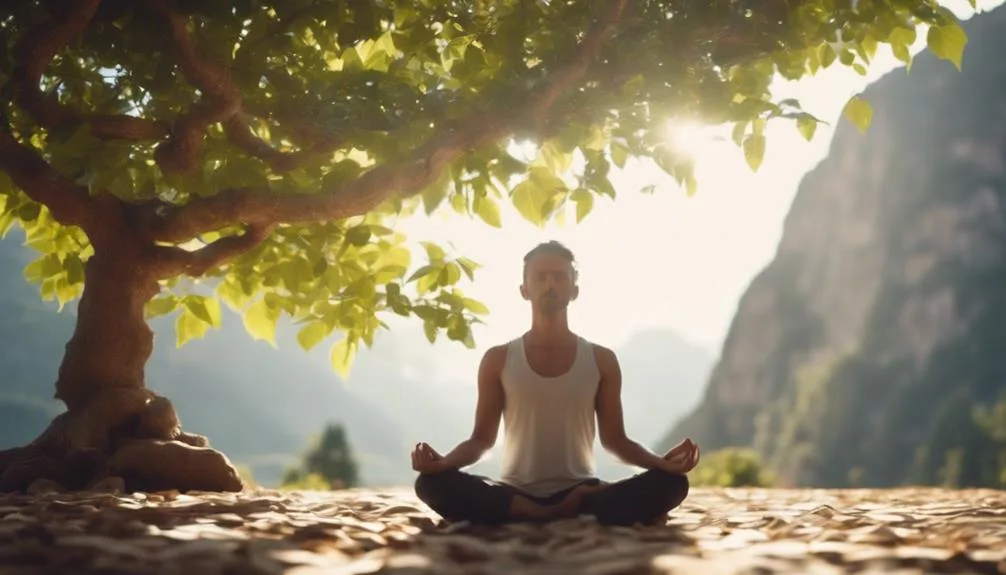Imagine possessing the power to silence the world's chaos with a single breath, guiding you into the deepest realms of meditation where true tranquility resides.
You've likely discovered that reaching this profound state isn't merely about sitting quietly; it demands intention, practice, and an openness to explore various techniques.
As you set your meditation space and calm your body and breath, remember that overcoming distractions and enhancing concentration are pivotal steps on this journey.
But how do you transition from these preparatory stages to experiencing the full depth of meditation?
Stay with me, and let's uncover the methods that can transform your practice and, ultimately, your life.
Key Takeaways
- Cultivate a serene environment with minimal distractions to enhance meditation depth.
- Prepare the body and mind through deep breathing and mindfulness for focused practice.
- Set clear intentions and use focus anchors to overcome distractions and deepen concentration.
- Reflect and journal post-meditation to integrate insights and maintain a peaceful state.
Setting Your Meditation Space
Why not begin your journey into deep meditation by creating a space that invites calmness and focus? Choosing a quiet and comfortable space is crucial. It minimizes distractions, allowing you to enhance your focus and sink into a deep state of meditation more easily. Ensure the lighting in your chosen area is soft and calming, setting the perfect ambiance for relaxation and deep breathing.
Incorporate a cushion or a meditation mat to support your posture. A proper posture isn't just about comfort; it's vital for maintaining focus and deepening your meditation practice. Adding elements like plants, candles, or soothing music can further create a serene atmosphere, making it easier for you to relax and concentrate.
Calming Body and Breath
Before diving into deep meditation, it's crucial to calm your body and breath, setting the stage for a profound and focused practice. Deep diaphragmatic breathing not only prepares your mind but activates the parasympathetic nervous system, ushering in a state of relaxation essential for meditation.
Here's how you can achieve this:
- Engage in deep breathing techniques, focusing on making your exhales longer than your inhales. This practice calms the mind and enhances your focus, creating an ideal state for meditation.
- Practice yoga poses like Setu Bandhasana (Bridge Pose) and Balasana (Child's Pose) to prepare your body. These poses help release physical tension, allowing for a calm and focused meditation session.
- Create a comfortable environment and posture for meditation. Ensuring your meditation space is inviting and comfortable enhances relaxation and concentration.
- Cultivate mindful body awareness by paying attention to each part of your body and consciously relaxing them. This awareness brings you into the present moment, ready for deep meditation.
Cultivating a Positive Mindset

Once your body and breath are calm, it's essential to cultivate a positive mindset to deepen your meditation experience. A key aspect of this is integrating positive affirmations and gratitude into your pre-meditation routine. Doing so not only enhances your focus but also prepares your mind for a more profound meditative state.
Here's a simple table to help you incorporate these elements into your meditation practice:
| Aspect | Technique | Benefit |
|---|---|---|
| Positive Affirmations | Repeat uplifting phrases to yourself. | Shifts mindset towards positivity. |
| Gratitude | Reflect on things you're thankful for. | Fosters a joyful, receptive state of mind. |
| Setting Intentions | Decide on a purpose for your session. | Directs your focus and deepens meditation. |
| Emotional Awareness | Observe feelings without judgment. | Increases self-awareness and inner peace. |
Embracing these practices before you begin meditating can significantly impact your ability to reach deep states of meditation. Remember, a happy mind is more receptive to the calming and mindfulness-promoting effects of meditation. By setting intentions, practicing gratitude, and using positive affirmations, you're not just preparing for meditation; you're cultivating a mindset that supports emotional awareness and inner peace.
Establishing Clear Intentions
As you prepare for meditation, setting clear intentions is a crucial step that focuses your mind and enriches your practice. Establishing clear intentions before you begin helps guide your mind, keeping your meditation practice from becoming just another routine. Knowing why you're sitting down to meditate not only enhances focus but also deepens the quality and depth of your practice, making it possible to enter a meditative state more fully.
Consider these intentions to guide your practice:
- To find inner peace and quiet the mind's chatter.
- To cultivate a deeper sense of self-awareness and mindfulness.
- To release negative emotions and foster a positive mindset.
- To connect with a higher state of consciousness and enhance spiritual growth.
These intentions act as a compass, steering you back whenever your mind wanders off, ensuring a deeper meditative experience. By clarifying your purpose, you're more likely to stay committed and fully engaged, allowing you to practice deep meditation more effectively.
Overcoming Distractions

Having set clear intentions for your meditation practice, you'll soon discover that managing distractions is a critical next step in deepening your focus and enhancing your experience. Recognizing that distractions are natural helps you approach them with a kinder, non-judgmental mindset. When you notice your mind wandering, gently guide your attention back to your chosen meditation object or breath. It's this act of returning your focus that strengthens your meditation muscle.
Use anchor points like body sensations or sounds to ground yourself in the present. Viewing distractions as opportunities for growth fosters deeper self-awareness. Below is a simple guide to help you navigate through distractions during your meditation journey:
| Strategy | Application | Benefit |
|---|---|---|
| Non-Judgmental Awareness | Observe distractions without criticism | Maintains focus, enhances self-awareness |
| Gently Redirecting | Guide attention back to breath or object of meditation | Strengthens focus, deepens meditation |
| Anchor Points | Use body sensations or sounds to refocus | Grounds in present, aids in concentration |
| Embrace Distractions | View as opportunities for growth | Encourages self-awareness, personal growth |
Enhancing Concentration
To enhance your concentration in meditation, start by settling your mind, allowing it to become calm and prepared for deeper focus.
Breath control techniques are essential; they help you maintain that calmness and keep your focus sharp.
Settling Your Mind
Focusing on a single point, such as your breath, a mantra, or a visual object, can significantly enhance your concentration during meditation. To settle your mind and achieve deep relaxation, consider these strategies:
- Utilize anchor points to gently guide your focus back when distractions arise.
- Cultivate mindfulness by observing your thoughts and sensations without judgment, allowing them to pass.
- Engage all your senses to ground yourself fully in the present moment, enriching your meditation experience.
- Gradually extend your meditation sessions to strengthen your mind's ability to remain focused and peaceful.
Breath Control Techniques
After mastering the art of settling your mind, exploring breath control techniques can significantly enhance your concentration during meditation.
| Technique | Benefits |
|---|---|
| Diaphragmatic Breathing | Promotes relaxation and focus by improving breathing patterns and increasing oxygen intake. |
| Alternate Nostril Breathing | Enhances cognitive function and aids in breath control by alternating breathing between nostrils. |
Incorporating these techniques into your meditation routine can deepen your focus, calm your mind, and enhance overall mindfulness. By practicing consistently, you're setting yourself up to experience deeper states of meditation. Remember, the key to successful breathing meditation lies in patience and persistence. Both diaphragmatic and alternate nostril breathing can transform your practice, elevating your concentration, relaxation, and focus to new heights.
Eliminating External Distractions
Creating a meditation space free from noise and distractions can significantly enhance your concentration during practice. Regular meditation in such a place can help you delve deeper into your practice, allowing you to let go of the outside world and focus more on the breath.
To make this a reality, consider:
- Choosing a quiet time for your practice, such as early mornings or late evenings.
- Using noise-canceling headphones or white noise machines.
- Selecting a dedicated place to meditate that's away from the hustle and bustle.
- Practicing mindfulness to acknowledge and then release external distractions without letting them disrupt your focus.
Transitioning Gently Post-Meditation
Once your meditation session concludes, it's crucial to transition back to your daily activities gently, ensuring you carry the tranquility and insights gained into the rest of your day. This gentle transition helps maintain the sense of calm and peace you've cultivated, slowly bringing you back to an awareness of your surroundings. It's a reflective moment, allowing you to acknowledge any insights or experiences that surfaced during your meditation.
The process of transitioning isn't just about moving from a state of meditation to your regular state of being; it's an opportunity for personal growth. Recognizing the benefits of your practice contributes significantly to your well-being and development. As you ease out of your meditative state, do so with intention, acknowledging the journey you've just undertaken.
Reflecting Through Journaling

Grabbing a journal to reflect on your meditation journey can significantly enhance your understanding and integration of the practice into your life. By jotting down thoughts and feelings post-meditation, you're not only deepening your self-awareness and mindfulness but also creating a tangible record of your progress. This act of reflecting through journaling serves as a powerful tool for personal growth, offering invaluable insights into how meditation impacts your daily routines and overall well-being.
Consider incorporating these elements in your journaling practice:
- Detailed descriptions of your meditation experiences, noting any challenges or breakthroughs.
- Emotional reflections to understand the depth of your feelings and thoughts during and after meditation.
- Patterns and progress tracking to observe your growth over time.
- Personal insights gained from each session, highlighting how meditation influences your life.
Frequently Asked Questions
How Do You Dive Deeper in Meditation?
To dive deeper in meditation, perfect your posture and set up a calm environment. Focus on your breath, reduce sensory input, use mantras, and practice visualization exercises. Detach mentally to reach profound meditation states.
How Long Does It Take to Get Into a Deep Meditative State?
Diving deep into meditation depends on personal readiness, daily practice, and dismantling mental barriers. It's essential to ensure physical comfort, consider environmental factors, and maintain emotional stability. With time flexibility, you'll find your pace.
What Is the Powerful Meditation Technique?
The powerful meditation technique you're asking about combines mindfulness breathing, mantra chanting, visualization, body scanning, walking meditation, loving kindness meditation, and zazen sitting. It'll deepen your practice, bringing profound peace and emotional well-being.
What Are the 7 States of Meditation?
Embarking on meditation's journey is like unlocking a treasure chest. The seven states range from mindful awareness to the transcendental state, incorporating Zen practice, Vipassana insight, loving kindness, concentration building, and chakra alignment.
Conclusion
Now, you've got the ultimate toolkit to dive into the ocean of deep meditation, where tranquility rules and chaos dissolves. Remember, setting up your sacred space is your first ticket to this blissful journey.
Taming your breath and body, you'll unlock secrets of the universe, while a positive mindset will be your shield against the darkest distractions. Embrace these practices, and watch as your concentration becomes sharper than a samurai's sword.
After each session, gently transition back, and let journaling capture the magic of your meditation marvels. You're not just meditating; you're transforming. Keep at it, and soon, you'll be the Zen master of your own mind.

